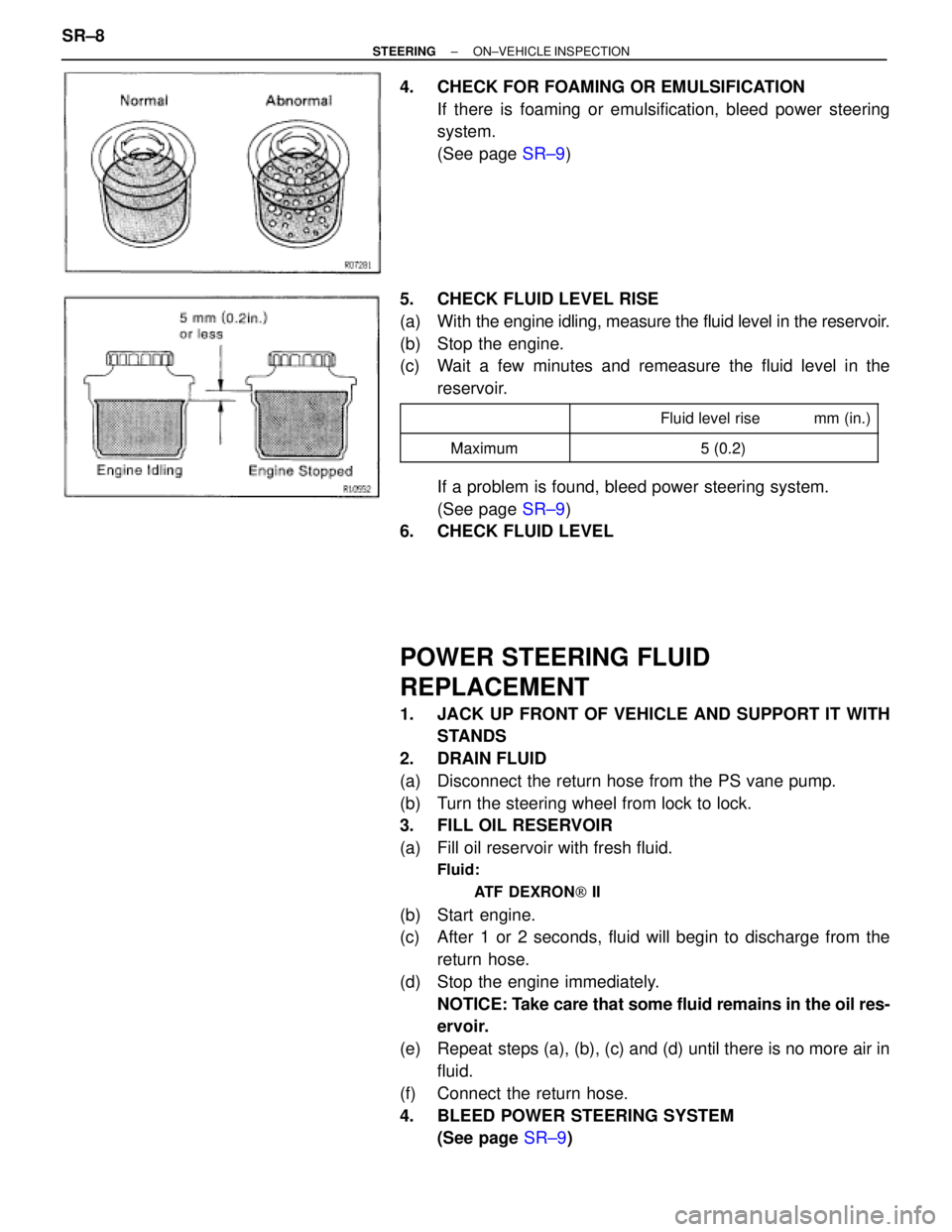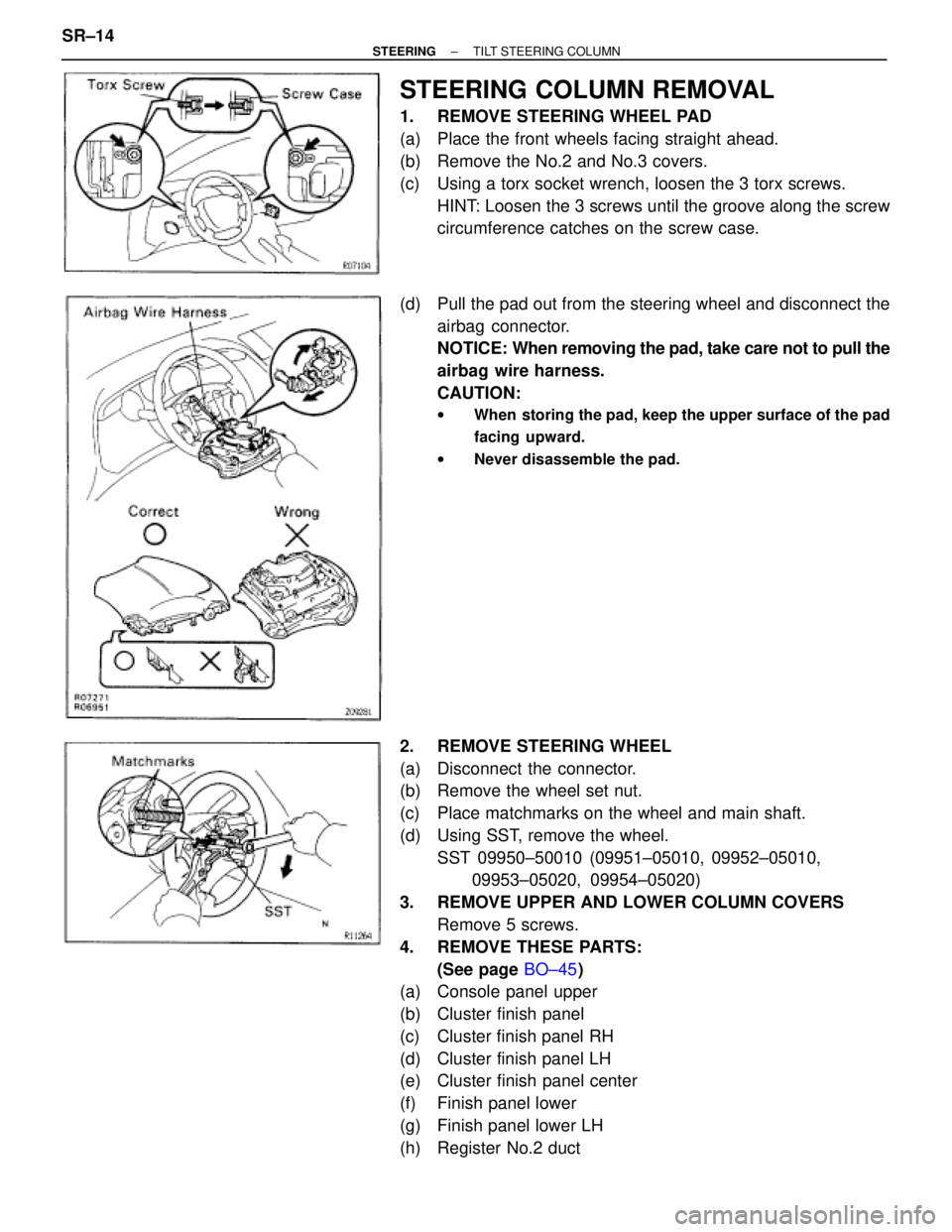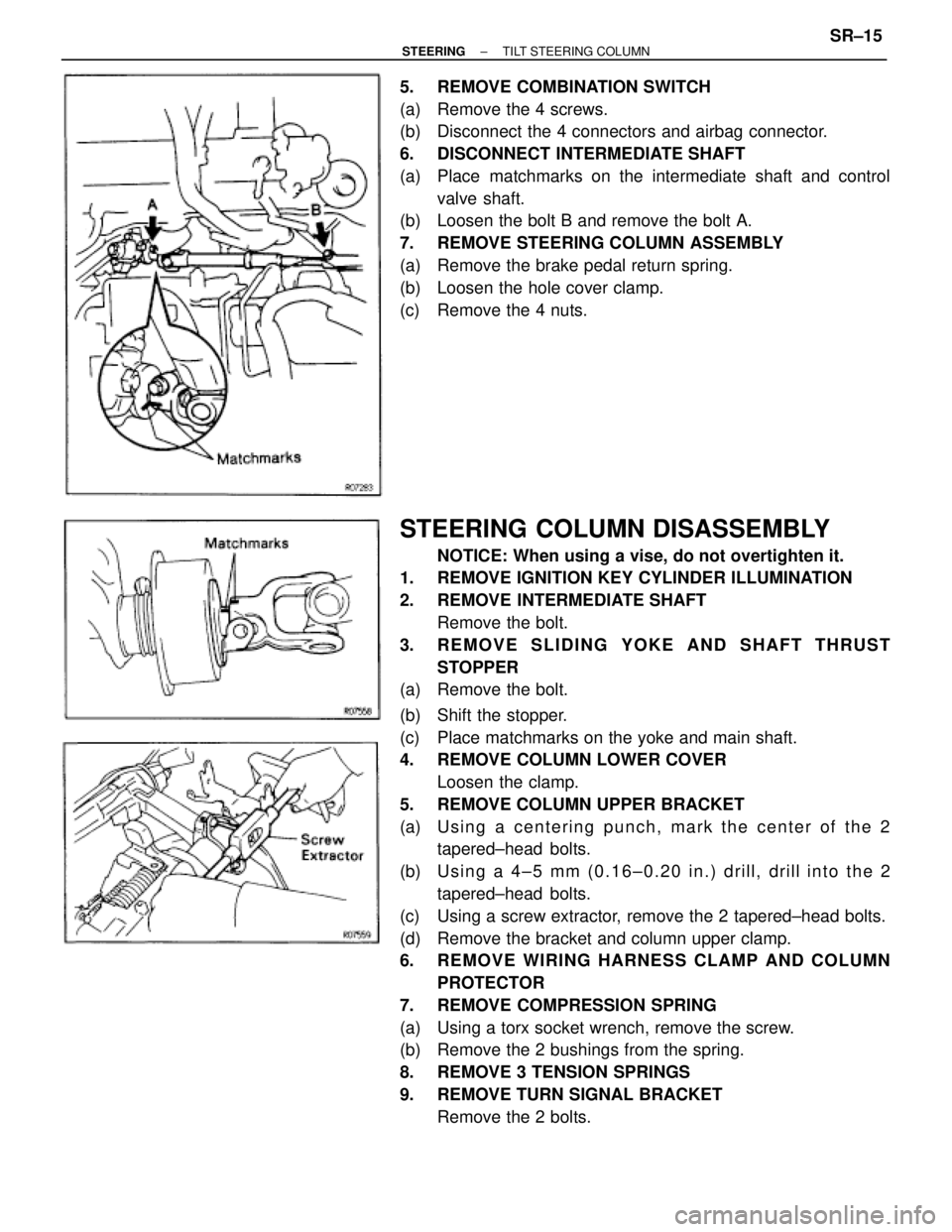Page 1639 of 2543

4. CHECK FOR FOAMING OR EMULSIFICATION
If there is foaming or emulsification, bleed power steering
system.
(See page SR±9)
5. CHECK FLUID LEVEL RISE
(a) With the engine idling, measure the fluid level in the reservoir.
(b) Stop the engine.
(c) Wait a few minutes and remeasure the fluid level in the
reservoir.
�������� �
������� ��������
�������������� �
������������� �������������� Fluid level rise mm (in.)
��������Maximum5(02)�������� ��������Maximum5 (0.2)
If a problem is found, bleed power steering system.
(See page SR±9)
6. CHECK FLUID LEVEL
POWER STEERING FLUID
REPLACEMENT
1. JACK UP FRONT OF VEHICLE AND SUPPORT IT WITH
STANDS
2. DRAIN FLUID
(a) Disconnect the return hose from the PS vane pump.
(b) Turn the steering wheel from lock to lock.
3. FILL OIL RESERVOIR
(a) Fill oil reservoir with fresh fluid.
Fluid:
ATF DEXRON[ II
(b) Start engine.
(c) After 1 or 2 seconds, fluid will begin to discharge from the
return hose.
(d) Stop the engine immediately.
NOTICE: Take care that some fluid remains in the oil res-
ervoir.
(e) Repeat steps (a), (b), (c) and (d) until there is no more air in
fluid.
(f) Connect the return hose.
4. BLEED POWER STEERING SYSTEM
(See page SR±9) SR±8
± STEERINGON±VEHICLE INSPECTION
Page 1640 of 2543
POWER STEERING SYSTEM BLEEDING
1. JACK UP FRONT OF VEHICLE AND SUPPORT IT WITH
STANDS
2. TURN STEERING WHEEL
With the engine stopped, turn the steering slowly from lock
to lock several times.
NOTICE: Take care that some fluid remains in the oil res-
ervoir.
3. LOWER VEHICLE
4. START ENGINE
Run the engine at idle for a few minutes.
5. TURN STEERING WHEEL
(a) With the engine at idling, turn the wheel to left or right full lock
and keep it there for 2±3 seconds, then turn the wheel to the
opposite full lock and keep it there for 2±3 seconds.
(b) Repeat (a) several times.
6. STOP ENGINE
7. CHECK FOR FOAMING OR EMULSIFICATION
If the system has to be bled twice specifically because of
foaming or emulsification, check for fluid leaks in the system.
8. CHECK FLUID LEVEL
(See page SR±7)
± STEERINGON±VEHICLE INSPECTIONSR±9
Page 1641 of 2543
FLUID PRESSURE CHECK
1. CONNECT OIL PRESSURE GAUGE
(a) Disconnect the pressure feed tube from the PS vane pump.
(See page SR±26)
(b) Connect the gauge over a new gasket, as shown below.
NOTICE: Check that the valve of the gauge is in the open
position.
2. BLEED POWER STEERING SYSTEM
(See page SR±9)
3. BOOST FLUID TEMPERATURE
(a) Start the engine and run it at idle.
(b) Turn the steering wheel from lock to lock several times to
boost fluid temperature.
Fluid temperature:
805C (1765F)
4. CHECK FLUID PRESSURE READING WITH VALVE
CLOSED
With the engine idling, close the oil pressure gauge valve and
observe the reading on the gauge.
������� ���������������������� ��������������� Fluid pressure kPa (kgf/cm2, psi)
������� �������Minimum7 355 (75 1 067)
�������
Minimum7,355 (75, 1,067)
NOTICE:
wDo not keep the valve closed for more than 10
seconds.
wDo not let the fluid temperature become too high. SR±10
± STEERINGON±VEHICLE INSPECTION
Page 1642 of 2543

5. CHECK FLUID PRESSURE READING WITH VALVE
OPENED
(a) With the engine idling, open the valve fully.
(b) Measure the fluid pressure at engine speeds of 1,000 rpm
and 3,000 rpm.
������� �
������ �������
���������������� �
��������������� ����������������Fluid pressure kPa (kgf/cm2, psi)
������� �������Difference���������������� ����������������490 (5, 71) or less
NOTICE: Do not turn the steering wheel.
6. CHECK FLUID PRESSURE READING WITH STEERING
WHEEL TURNED TO FULL LOCK
With the engine idling and valve fully opened, turn the wheel
to full lock.
������� ����������������������� ���������������� Fluid pressure kPa (kgf/cm2, psi)������� �
������ �������Minimum
���������������� �
��������������� ����������������7,355 (75, 1,067)
NOTICE:
wDo not maintain lock position for more than 10
seconds.
wDo not let the fluid temperature become too high.
7. DISCONNECT OIL PRESSURE GAUGE
(a) Disconnect the pressure gauge.
(b) Connect the pressure feed tube.
(See page SR±32)
8. BLEED POWER STEERING SYSTEM
(See page SR±9)
STEERING EFFORT MEASUREMENT
1. CENTER STEERING WHEEL
2. MEASURE STEERING EFFORT
(a) Remove the steering wheel pad.
(See page SR±14)
(b) Start the engine and run it at idle.
(c) Measure the steering effort in both directions.
Maximum steering effort:
6.9 NVm (70 kgfVcm, 61 in.Vlbf)
If steering effort is excessive, repair the power steering unit.
HINT: Be sure to consider the tire type, pressure and contact
surface before making your diagnosis.
(d) Tighten the steering wheel set nut.
Torque: 35 NVm (360 kgfVcm, 26 ftVlbf)
(e) Install the steering wheel pad.
(See page SR±22)
± STEERINGON±VEHICLE INSPECTIONSR±11
Page 1643 of 2543
TILT STEERING COLUMN
COMPONENTS
SR±12± STEERINGTILT STEERING COLUMN
Page 1644 of 2543
COMPONENTS
± STEERINGTILT STEERING COLUMNSR±13
Page 1645 of 2543

STEERING COLUMN REMOVAL
1. REMOVE STEERING WHEEL PAD
(a) Place the front wheels facing straight ahead.
(b) Remove the No.2 and No.3 covers.
(c) Using a torx socket wrench, loosen the 3 torx screws.
HINT: Loosen the 3 screws until the groove along the screw
circumference catches on the screw case.
(d) Pull the pad out from the steering wheel and disconnect the
airbag connector.
NOTICE: When removing the pad, take care not to pull the
airbag wire harness.
CAUTION:
wWhen storing the pad, keep the upper surface of the pad
facing upward.
wNever disassemble the pad.
2. REMOVE STEERING WHEEL
(a) Disconnect the connector.
(b) Remove the wheel set nut.
(c) Place matchmarks on the wheel and main shaft.
(d) Using SST, remove the wheel.
SST 09950±50010 (09951±05010, 09952±05010,
09953±05020, 09954±05020)
3. REMOVE UPPER AND LOWER COLUMN COVERS
Remove 5 screws.
4. REMOVE THESE PARTS:
(See page BO±45)
(a) Console panel upper
(b) Cluster finish panel
(c) Cluster finish panel RH
(d) Cluster finish panel LH
(e) Cluster finish panel center
(f) Finish panel lower
(g) Finish panel lower LH
(h) Register No.2 duct SR±14
± STEERINGTILT STEERING COLUMN
Page 1646 of 2543

5. REMOVE COMBINATION SWITCH
(a) Remove the 4 screws.
(b) Disconnect the 4 connectors and airbag connector.
6. DISCONNECT INTERMEDIATE SHAFT
(a) Place matchmarks on the intermediate shaft and control
valve shaft.
(b) Loosen the bolt B and remove the bolt A.
7. REMOVE STEERING COLUMN ASSEMBLY
(a) Remove the brake pedal return spring.
(b) Loosen the hole cover clamp.
(c) Remove the 4 nuts.
STEERING COLUMN DISASSEMBLY
NOTICE: When using a vise, do not overtighten it.
1. REMOVE IGNITION KEY CYLINDER ILLUMINATION
2. REMOVE INTERMEDIATE SHAFT
Remove the bolt.
3. REMOVE SLIDING YOKE AND SHAFT THRUST
STOPPER
(a) Remove the bolt.
(b) Shift the stopper.
(c) Place matchmarks on the yoke and main shaft.
4. REMOVE COLUMN LOWER COVER
Loosen the clamp.
5. REMOVE COLUMN UPPER BRACKET
(a) U s i n g a c e n t e r i n g p u n c h , m a r k t h e c e n t e r o f t h e 2
tapered±head bolts.
(b) U s i n g a 4 ± 5 m m ( 0 .16±0.20 in.) drill, drill into the 2
tapered±head bolts.
(c) Using a screw extractor, remove the 2 tapered±head bolts.
(d) Remove the bracket and column upper clamp.
6. REMOVE WIRING HARNESS CLAMP AND COLUMN
PROTECTOR
7. REMOVE COMPRESSION SPRING
(a) Using a torx socket wrench, remove the screw.
(b) Remove the 2 bushings from the spring.
8. REMOVE 3 TENSION SPRINGS
9. REMOVE TURN SIGNAL BRACKET
Remove the 2 bolts.
± STEERINGTILT STEERING COLUMNSR±15